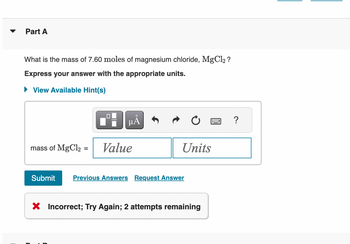
Chemistry
10th Edition
ISBN: 9781305957404
Author: Steven S. Zumdahl, Susan A. Zumdahl, Donald J. DeCoste
Publisher: Cengage Learning
expand_more
expand_more
format_list_bulleted
Concept explainers
Question

Transcribed Image Text:▼
Part A
What is the mass of 7.60 moles of magnesium chloride, MgCl2 ?
Express your answer with the appropriate units.
View Available Hint(s)
mass of MgCl2
=
μÃ
Value
Units
Submit Previous Answers Request Answer
X Incorrect; Try Again; 2 attempts remaining
?
Expert Solution
This question has been solved!
Explore an expertly crafted, step-by-step solution for a thorough understanding of key concepts.
This is a popular solution
Trending nowThis is a popular solution!
Step by stepSolved in 3 steps with 4 images

Knowledge Booster
Learn more about
Need a deep-dive on the concept behind this application? Look no further. Learn more about this topic, chemistry and related others by exploring similar questions and additional content below.Similar questions
- I need answers for number 13arrow_forwardCalculate the mass of 2.6 moles of magnesium. Answer: _ g Mgarrow_forwardThis is the chemical formula for nickel tetracarbonyl (a powerfully poisonous liquid used in nickel refining):NiCO4 A chemical engineer has determined by measurements that there are 0.0407 moles of nickel in a sample of nickel tetracarbonyl. How many moles of carbon are in the sample? Round your answer to 3 significant digits.arrow_forward
- The number of N atoms in 10.0 moles of NH 3 (subscript)arrow_forwardThis is the chemical formula for nickel tetracarbonyl (a powerfully polsonous liquid used in nickel refining): Ni(CO), A chemical engineer has determined by measurements that there are 18.8 moles of nickel in a sample of nickel tetracarbonyl. How many moles of carbon are in the sample? Round your answer to 3 significant digits.arrow_forwardplz solve it within 30-40 mins I'll give you multiple upvotearrow_forward
- How many moles are in 5.83 g of the compound Happyase if it has a molar mass of 40.24 g/mol? (enter only your numeric answer, do not use scientific notation, include 2 decimal points in your answer)arrow_forwardPart A What is the molar mass of butane, C4H10? Express your answer to four significant figures and include the appropriate units. ► View Available Hint(s) HÅ Value undo Units Submit Previous Answers Incorrect: Try Again B ?arrow_forwardResults table. To clean up, zoom out from the balance and drag the sample to the red disposal container. Repeat with ammonium chloride (NH4Cl), located on the Salts shelf. C12H22O11 NH4ClMass (g) 1.0481 g 1.0444g Molar Mass (g/mol)MolesMoles of each elementAtoms of each element Much like the previous calculation, you will use the periodic table to determine the molar massof the compound. The example shown is for sodium chloride, NaCl. The molar mass is the massof 1 sodium (22.98g/mole) and 1 chlorine (35.45g/mole) added together, 58.43g/mole. If theformula shows multiple atoms, as in sugar, you must take that into account. For sugar, it will be12 times the mass of a carbon atom plus 22 time the mass of hydrogen atom, plus 11 times themass of oxygen atoms.The calculation of moles will be similar to that done in the previous…arrow_forward
- Using a chemical equation to find moles of product from moles... Try Again Your answer is wrong. In addition to checking your math, check that you used the right data and DID NOT round any intermediate calculations. Gaseous ammonia chemically reacts with oxygen (0₂) gas to produce nitrogen monoxide gas and water vapor. Calculate the moles of oxygen needed to produce 0.065 mol of nitrogen monoxide. Be sure your answer has a unit symbol, if necessary, and round it to 2 significant digits. 0.098 mol Explanation Recheck X ロ・ロ S Try again.... 0/5 4 Ⓒ2022 McGraw Hill LLC. All Rights Reserved. Terms of Use Privacy Center Accessibilarrow_forwardHow many atoms in 6.255 mol of each of the following: (Enter your answer in scientific notation using the correct number of significant figures.) • help: scientific notation format (a) Fe: atoms (b) H2: atoms (c) H2SO4: atomsarrow_forward
arrow_back_ios
arrow_forward_ios
Recommended textbooks for you
 ChemistryChemistryISBN:9781305957404Author:Steven S. Zumdahl, Susan A. Zumdahl, Donald J. DeCostePublisher:Cengage Learning
ChemistryChemistryISBN:9781305957404Author:Steven S. Zumdahl, Susan A. Zumdahl, Donald J. DeCostePublisher:Cengage Learning ChemistryChemistryISBN:9781259911156Author:Raymond Chang Dr., Jason Overby ProfessorPublisher:McGraw-Hill Education
ChemistryChemistryISBN:9781259911156Author:Raymond Chang Dr., Jason Overby ProfessorPublisher:McGraw-Hill Education Principles of Instrumental AnalysisChemistryISBN:9781305577213Author:Douglas A. Skoog, F. James Holler, Stanley R. CrouchPublisher:Cengage Learning
Principles of Instrumental AnalysisChemistryISBN:9781305577213Author:Douglas A. Skoog, F. James Holler, Stanley R. CrouchPublisher:Cengage Learning Organic ChemistryChemistryISBN:9780078021558Author:Janice Gorzynski Smith Dr.Publisher:McGraw-Hill Education
Organic ChemistryChemistryISBN:9780078021558Author:Janice Gorzynski Smith Dr.Publisher:McGraw-Hill Education Chemistry: Principles and ReactionsChemistryISBN:9781305079373Author:William L. Masterton, Cecile N. HurleyPublisher:Cengage Learning
Chemistry: Principles and ReactionsChemistryISBN:9781305079373Author:William L. Masterton, Cecile N. HurleyPublisher:Cengage Learning Elementary Principles of Chemical Processes, Bind...ChemistryISBN:9781118431221Author:Richard M. Felder, Ronald W. Rousseau, Lisa G. BullardPublisher:WILEY
Elementary Principles of Chemical Processes, Bind...ChemistryISBN:9781118431221Author:Richard M. Felder, Ronald W. Rousseau, Lisa G. BullardPublisher:WILEY

Chemistry
Chemistry
ISBN:9781305957404
Author:Steven S. Zumdahl, Susan A. Zumdahl, Donald J. DeCoste
Publisher:Cengage Learning

Chemistry
Chemistry
ISBN:9781259911156
Author:Raymond Chang Dr., Jason Overby Professor
Publisher:McGraw-Hill Education

Principles of Instrumental Analysis
Chemistry
ISBN:9781305577213
Author:Douglas A. Skoog, F. James Holler, Stanley R. Crouch
Publisher:Cengage Learning

Organic Chemistry
Chemistry
ISBN:9780078021558
Author:Janice Gorzynski Smith Dr.
Publisher:McGraw-Hill Education

Chemistry: Principles and Reactions
Chemistry
ISBN:9781305079373
Author:William L. Masterton, Cecile N. Hurley
Publisher:Cengage Learning

Elementary Principles of Chemical Processes, Bind...
Chemistry
ISBN:9781118431221
Author:Richard M. Felder, Ronald W. Rousseau, Lisa G. Bullard
Publisher:WILEY